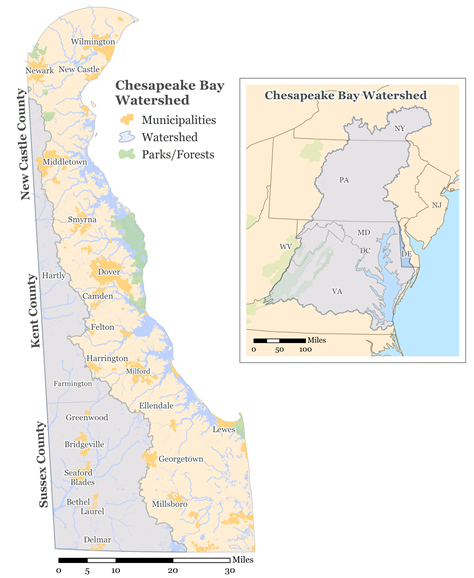The DNREC Chesapeake Implementation Program administers water quality focused programs and manages grants that fund projects within the Delaware portion of the Chesapeake Bay Watershed designed to reduce nonpoint source (NPS) pollution.
The Chesapeake Bay Watershed includes parts of six states — Delaware, Maryland, Virginia, West Virginia, Pennsylvania and New York — and the District of Columbia. Delaware’s portion of the watershed includes all three counties, running down the western side of the state and including much of the western Sussex County.
Delaware is considered a headwater state for the Chesapeake Bay Watershed, having tidal and non-tidal waters leading to the Chesapeake Bay.
The Chesapeake Bay and the many streams and waterways that drain to the Bay from each state suffer from excess pollution loads and must be cleaned up. To help address this issue, Delaware developed Total Maximum Daily Loads (TMDLs) as early as 1998 that set limits on the amount of pollution that can be discharged into waterbodies that do not yet meet the state’s water quality standards.
Delaware is also a signatory of the 2014 Chesapeake Bay Watershed Agreement and is currently in Phase 3 of its Watershed Implementation Plan (WIP), which creates a strategic path forward to reducing nutrient and sediment loads by 2025.
In Delaware, waterways that drain to the Chesapeake Bay include the Bohemia Creek, Broad Creek, C & D Canal West, Chester River, Choptank River, Deep Creek, Elk Creek , Gravelly Branch, Gum Branch, Marshyhope Creek, Nanticoke River, Perch Creek, Pocomoke River, Sassafras River and Wicomico River.

The Chesapeake Implementation Program oversees a group of funding programs to help local governments, community groups and landowners in the Chesapeake Bay Watershed take actions and make changes that can help protect and improve water quality in the watershed.
Chesapeake Bay Implementation Grant (CBIG) funds from the EPA enable states in the watershed to meet the goals of the 2014 Chesapeake Bay Watershed Agreement, including improving water quality and achieving Total Maximum Daily Loads (TMDLs) for pollutants of concern.
The Delaware Community Conservation Assistance Program (DeCAP) is a cost-share program that provides financial incentives, technical and educational assistance to property owners for installing eligible Best Management Practices (BMPs) in Delaware’s portion of the Chesapeake Bay Watershed.
The Buffer Incentive Program offers incentives for urban and agricultural landowners to install forest and grass buffers along waterways within the watershed. Eligible landowners that qualify will receive an incentive payment for land they enroll in the program.
Clean Water Act Section 319 Funding
Surface Water Matching Planning Grants
Community Water Quality Improvement Grants
Conservation Reserve Enhancement Program
Chesapeake Bay Watershed Implementation Plan
Chesapeake Bay Watershed Implementation Plan Milestones
Local Government Guide to the Chesapeake Bay Module Series
Watershed Plans and Pollution Control Strategies
Related Topics: chesapeake bay, conservation, grants, nonpoint source, water quality, watershed, watershed stewardship